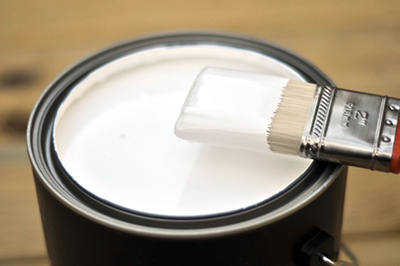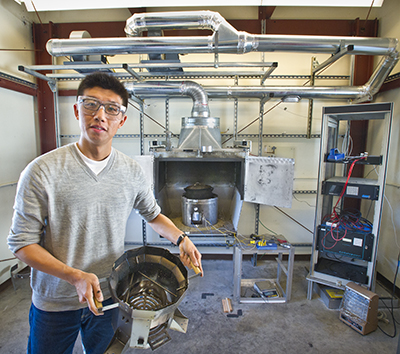Most people spend the majority of their time inside, often affected by a variety of factors both seen and unseen. We are working to understand and mitigate indoor pollutants.
Overview
Indoor air quality is affected by a variety of factors both seen and unseen, from mold and cooking smoke to invisible pollutants and inefficient HVAC systems. These factors can affect people's comfort, health and performance at work or school.
Some pollutants increase the risk of cancers or respiratory problems, while others can cause infectious diseases such as the common cold or influenza. See the focus areas below to learn more about how we are working to better understand and improve indoor environments.

Pollutant Exposures, Health and Productivity
People are exposed to indoor pollutants in the air, in dust and on surfaces. We investigate the size of these exposures by measuring sets of buildings and modeling exposures. We examine how exposures are affected by:
- the types of materials and products used in the building and in the building's furnishings and equipment
- the rates and methods of ventilation
- the patterns of indoor airflow
- the use of various types of filtration systems for removing particles and gaseous pollutants
- temperature and humidity
- indoor chemical reactions
- occupant behaviors such as direct use of various sources of pollutants, cooking and operation of range hoods and activities that re-suspend particles from surfaces
We also research how exposures to air pollutants and related features of buildings affect people's health and their work and school performance. As part of this work, we estimate the economic costs of indoor environmental exposures and the economic benefits of undertaking various measures to improve indoor environmental quality.

Energy-Efficient Building Ventilation
Ventilation is the supply of outdoor air to buildings. It can help reduce indoor concentrations of indoor-generated air pollutants, but it can also increase the presence of pollutants that come from outdoors. Under many conditions, ventilation increases building energy use, because admitted outdoor air must be heated, cooled and/or dehumidified.
Berkeley Lab has a long history of research on building ventilation. We study how rates and methods of ventilation, including natural ventilation, affect indoor air pollutant concentrations as well as prevalence rates of acute "sick building" health symptoms, absence rates, work performance and the risks of chronic adverse health effects. We study ways to measure ventilation rates, the use of sensors to automatically control ventilation and the effect of ventilation on building energy use. A key goal is to identify or develop the technologies and practices needed to maintain good indoor air quality without using more energy than necessary.
Energy-Efficient Air Quality Control Technologies
We are developing and evaluating energy-efficient ways to effectively clean the air. Different methods can be used to remove pollutants such as volatile organic compounds (VOCs) and particles from indoor air. These include mature technologies relying on adsorption or chemisorption; and emerging technologies based on room-temperature catalysis and photocatalysis. We carry out research to evaluate and optimize the performance of novel air-cleaning technologies that remove indoor VOCs. We also develop methods to test air-cleaning devices under realistic conditions.

Pollutant Sources, Sinks and Chemical Transformations
Multiple sources contribute to indoor pollutant levels, including cooking, heating, carpets, furniture and building materials. Our work has characterized these sources and the various methods used to control them. Recent studies have highlighted how hydrolysis of binders used in fiberglass ventilation filters can become a source of fomaldehyde—a common indoor pollutant emitted by multiple sources—in conditions of high relative humidity. Another study described the impact of using cleaners and air fresheners indoors, considering not only the VOC emissions associated with these household products, but also their reaction with indoor ozone, leading to the formation of ultrafine particles and volatile aldehydes.
Efficient and Healthy Schools Campaign
The Efficient and Healthy Schools campaign aims to engage K-12 schools to improve energy performance and indoor air quality, with a focus on practical solutions involving HVAC and other technologies to reduce energy use and carbon emissions. This campaign is led by the U.S. Department of Energy with organizing partners: the U.S. Environmental Protection Agency (EPA) and the U.S. Department of Education (ED) with technical support from Berkeley Lab. efficienthealthyschools.lbl.gov
Indoor Air Quality in Developing Countries
Cookstoves developed at Berkeley Lab are saving lives around the world. The Cookstoves Group at Berkeley Lab designs, develops, and evaluates low-emission, fuel-efficient and culturally viable cookstoves with the goal of reducing the environmental, monetary and health burden on relevant populations in poorer countries. We strive to provide rigorous scientific testing of these and other improved stoves to validate claims of improved cooking. Currently, the Cookstoves Group is recognized as the world authority on design, development, and testing of efficient cookstoves. The group has successfully built and maintained a gold standard cookstove testing facility, identified scientific underpinnings for reducing harmful cookstove emissions by 90%, developed training videos to elevate research capabilities worldwide, conducted field testing in Haiti, India, Ethiopia, Uganda, and Mongolia, and participates in development of international standards for laboratory testing of cookstoves.
is recognized as the world authority on design, development, and testing of efficient cookstoves. The group has successfully built and maintained a gold standard cookstove testing facility, identified scientific underpinnings for reducing harmful cookstove emissions by 90%, developed training videos to elevate research capabilities worldwide, conducted field testing in Haiti, India, Ethiopia, Uganda, and Mongolia, and participates in development of international standards for laboratory testing of cookstoves.
Links
- Healthy Efficient Homes: homes.lbl.gov
- Efficient and Healthy Schools: efficienthealthyschools.lbl.gov
- Indoor Environment Group: indoor.lbl.gov
- Indoor Air Quality Scientific Findings Resource Bank: iaqscience.lbl.gov
- Cookstoves: cookstoves.lbl.gov


